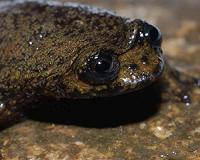| . |  |
. |
Kuala Lumpur (AFP) April 22, 2010 Wildlife researchers said Thursday they have discovered around 120 new species on Borneo island, including a lungless frog, the world's longest insect and a slug that fires "love darts" at its mate. Conservation group WWF listed the new finds in a report on a remote area of dense, tropical rainforest that borders Malaysia, Indonesia and Brunei on Borneo. The three governments in 2007 designated the 220,000-square-kilometre (88,000-square-mile) area as the "Heart of Borneo" in a bid to conserve the rainforest. "We have been finding on average three new species a month and about 123 over the last three years, with at least 600 new species found in the last 15 years," Adam Tomasek, head of WWF's Heart of Borneo initiative told AFP from Brunei. "The new discoveries just show the wealth of biodiversity on Borneo island and the promise of many more future discoveries that could eventually help cure illnesses like cancer and AIDS and contribute to our daily lives," he said. The "Heart of Borneo" region is home to 10 species of primate, more than 350 birds, 150 reptiles and amphibians and about 10,000 plants that are not found anywhere else in the world, the report said. Among the finds are a seven-centimetre (three-inch) flat-headed frog, known as "Barbourula kalimantanensis", discovered in 2008, which breathes entirely through its skin instead of lungs. Researchers in the same year also discovered "Phobaeticus chani", the world's longest stick insect, with a body 36 centimetres long. Only three specimens of the creature have ever been found. Another interesting find was a long-tailed slug that uses "love darts" made of calcium carbonate to pierce and inject a hormone into a mate to increase the chances of reproduction. The WWF urged governments act sensitively when developing the area's economic potential. "We know that it is impossible for the three governments not to have development in mining, oil palm plantations and logging in the area," Tomasek said. "What we want to have is a balance so that we have a foundation of conservation and sustainable development in order to protect this unique site for future generations," he added. Indonesia and Malaysia, the world's two largest exporters of palm oil, account for 85 percent of global production. Palm oil -- used extensively across the globe for biofuel, processed food and toiletries -- has been vilified by environmental campaigners for causing deforestation and threatening the survival of near-extinct species. Tomasek said the "Heart of Borneo" initiative is also important for protecting the habitat of endangered species such as the pygmy elephant, orangutan, rhinoceros and clouded leopard. "In many ways this is the last stronghold for the long-term survival of these species," he said. The Sumatran rhinoceros is one of the world's most endangered species, with only about 200 remaining in the wild, up to 180 in Indonesia and the rest in Malaysia. The Bornean sub-species is the rarest of all rhinos, with just 30 left in the wild on Borneo island. Conservationists also warned the world has less than 20 years left to save about 50,000 to 60,000 of the charismatic red-haired orangutans left in the wild.
Share This Article With Planet Earth
Related Links Darwin Today At TerraDaily.com
 'Love-dart' slug, lungless frog among new species on Borneo
'Love-dart' slug, lungless frog among new species on BorneoKuala Lumpur (AFP) April 22, 2010 Wildlife researchers said Thursday they have discovered 123 new species on Borneo island, including a lungless frog, the world's longest insect and a slug that fires "love darts" at its mate. Conservation group WWF listed the new finds in a report on a remote area of dense, tropical rainforest that borders Malaysia, Indonesia and Brunei on Borneo. The three governments in 2007 designated ... read more |
|
| The content herein, unless otherwise known to be public domain, are Copyright 1995-2010 - SpaceDaily. AFP and UPI Wire Stories are copyright Agence France-Presse and United Press International. ESA Portal Reports are copyright European Space Agency. All NASA sourced material is public domain. Additional copyrights may apply in whole or part to other bona fide parties. Advertising does not imply endorsement,agreement or approval of any opinions, statements or information provided by SpaceDaily on any Web page published or hosted by SpaceDaily. Privacy Statement |